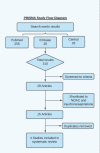The Risk of Bleeding Complications in Intra-Articular Injections and Arthrocentesis in Patients on Novel Oral Anticoagulants: A Systematic Review
- PMID: 34659968
- PMCID: PMC8493764
- DOI: 10.7759/cureus.17755
The Risk of Bleeding Complications in Intra-Articular Injections and Arthrocentesis in Patients on Novel Oral Anticoagulants: A Systematic Review
Abstract
Novel oral anticoagulants (NOACs) are increasingly prescribed blood-thinning medication. Surpassing Warfarin, NOACs are more favored and extensively used in paroxysmal atrial fibrillation, acute coronary syndrome, and in elderly patients. Well-known benefits of novel oral anticoagulants include predictable pharmacokinetics, pharmacodynamics, and shorter half-life. However, as with any anticoagulant, there are bleeding risks with NOACs. There is a lack of evidence and consensus on the management of novel anticoagulants for intraarticular injections and arthrocentesis. This systematic review aims to analyze the risk of bleeding complications in patients on novel oral anticoagulants who underwent joint injections and arthrocentesis to help physicians in the decision-making and consenting process. A literature search of three online databases was completed using the Cochrane methodology for systematic reviews. Eligibility criteria included any study that reported bleeding complication rates in adult patients on novel oral anticoagulants that had a joint injection or aspiration whilst continuing their regular oral anticoagulation. All studies with any number of patients and published in any language were included. Review articles and systematic reviews were excluded. The search of databases resulted in a total of 310 articles. After screening, a total of four articles were deemed suitable to be included in the analysis. These described a total of 668 patients undergoing injections/aspiration procedures with patients on three different novel oral anticoagulants namely Rivaroxaban, Apixaban, and Dabigatran. Only one patient joint had a bleeding complication and the patient was on Dabigatran. The results of this systematic review show that it is relatively safe to perform joint injections and arthrocentesis whilst continuing on Novel oral anticoagulation.
Keywords: arthrocentesis; bleeding; doac; intra-articular injection; noacs.
Copyright © 2021, Tarar et al.
Conflict of interest statement
The authors have declared that no competing interests exist.
Figures
Similar articles
-
Arthrocentesis and Joint Injection in Patients Receiving Direct Oral Anticoagulants.Mayo Clin Proc. 2017 Aug;92(8):1223-1226. doi: 10.1016/j.mayocp.2017.04.007. Mayo Clin Proc. 2017. PMID: 28778256
-
Effectiveness and Safety of Contemporary Oral Anticoagulants Among Asians With Nonvalvular Atrial Fibrillation.Stroke. 2019 Aug;50(8):2245-2249. doi: 10.1161/STROKEAHA.119.025536. Epub 2019 Jun 18. Stroke. 2019. PMID: 31208303
-
Direct comparative effectiveness and safety between non-vitamin K antagonist oral anticoagulants for stroke prevention in nonvalvular atrial fibrillation: a systematic review and meta-analysis of observational studies.Eur J Epidemiol. 2019 Feb;34(2):173-190. doi: 10.1007/s10654-018-0415-7. Epub 2018 Jun 8. Eur J Epidemiol. 2019. PMID: 29948370
-
Effectiveness and safety of reduced dose non-vitamin K antagonist oral anticoagulants and warfarin in patients with atrial fibrillation: propensity weighted nationwide cohort study.BMJ. 2017 Feb 10;356:j510. doi: 10.1136/bmj.j510. BMJ. 2017. PMID: 28188243 Free PMC article.
-
Meta-analysis of efficacy and safety of new oral anticoagulants compared with warfarin in Japanese patients undergoing catheter ablation for atrial fibrillation.J Interv Card Electrophysiol. 2020 Sep;58(3):381-399. doi: 10.1007/s10840-020-00784-0. Epub 2020 May 27. J Interv Card Electrophysiol. 2020. PMID: 32458179 Review.
Cited by
-
To stop or not to stop novel oral anticoagulants prior to performing joint interventional maneuvers? Evidence from a prospective study that the therapy can be maintained.Clin Rheumatol. 2024 Sep;43(9):2983-2992. doi: 10.1007/s10067-024-07048-6. Epub 2024 Jul 15. Clin Rheumatol. 2024. PMID: 39008221
-
EUROVISCO Good Practice Recommendations for a First Viscosupplementation in Patients with Knee Osteoarthritis.Cartilage. 2023 Jun;14(2):125-135. doi: 10.1177/19476035221138958. Epub 2022 Nov 28. Cartilage. 2023. PMID: 36443990 Free PMC article.
References
-
- Predictors of NOAC versus VKA use for stroke prevention in patients with newly diagnosed atrial fibrillation: Results from GARFIELD-AF. Haas S, Camm AJ, Bassand JP, et al. Am Heart J. 2019;213:35–46. - PubMed
-
- Use of direct oral anticoagulants in daily practice. Almarshad F, Alaklabi A, Bakhsh E, Pathan A, Almegren M. https://pubmed.ncbi.nlm.nih.gov/30697449/ Am J Blood Res. 2018;8:57–72. - PMC - PubMed
Publication types
LinkOut - more resources
Full Text Sources

